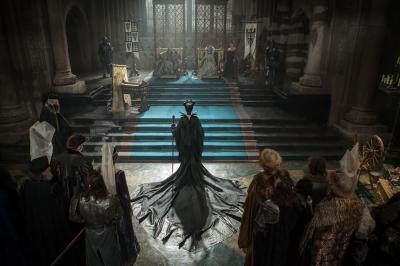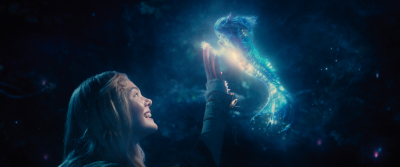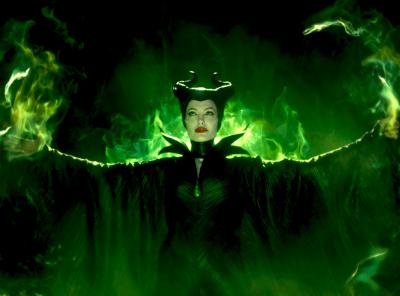By: debbie lynn elias
With script by Linda Woolverton and John Lee Hancock, and led by animator/artist/ production designer/art director/VFX and two-time Oscar winner Robert Stromberg, who makes his directorial debut (finally!), MALEFICENT has cast its spell on the world. Crossing the $200 million mark this weekend, MALEFICENT’s success proves that nobody does fairy tales better than Disney and thanks to some great imagination and exquisite storytelling that adds a new twist to classic legend and lore, brought to life with breathtaking visuals that stun, immerse, dazzle with heart-stopping beauty and emotion, infused with an indelible powerhouse performance by Angelina Jolie, it’s obvious why MALEFICENT wraps you in the most magical of spells. And it’s thanks to the guiding eye of director Robert Stromberg that MALEFICENT is as magnificent as it is.
I seriously doubt that any director other than Robert Stromberg (even a visualist like Tim Burton) could have stepped in and brought MALEFICENT to life with such incredible detail, depth and texture, creating a tonal bandwidth that finds the perfect balance and discussion of good versus evil, love versus hate. With Stromberg’s background in VFX, production design, art direction and even old school matte painting background, he puts every bit of skill and every element to use in the design of MALEFICENT. Then you toss in Dean Semler’s lighting and lensing and the screen dazzles with a delicate emotional and tonal balance that mirrors the delicacy of fairy spells.
As he even bragged to the publicists with an immediate “we go way back” on my entering the room, Robert Stromberg and I have crossed paths countless times over the past almost 30 years both in and out of the production arena. Seeing his work and watching his talents expand and grow over the years has been a privilege, so it’s always a joy to reconnect and catch up, but never moreso than now with this exclusive 1:1 interview as this is our first meeting where Bob is now a bonafide “director”; something I have long believed he was destined to do.

I have to say right out of the box, Bob, that no one but you with your disciplines and creative skills and background could have made MALEFICENT. This is mesmerizing. It is magical. It is masterful. I fell in love with this while watching.
Aaah! What a great thing to say. Wow. What a great compliment. Thank you.
Between you and Dean Semler [cinematographer], the two of you created palettes with the moors that herald an ethereal beauty that harkens to a Maxfield Parrish painting.
There was some inspiration there for sure. I’ve always been a big fan of Hudson River School, the artists of that ilk, Frederick Church and Albert Bierstadt and those guys. Dean, ironically – we talked about that – knew all about that because they were able to accomplish with just paint a great mood in the lighting of that they were painting. . . Dean’s a great guy and I think we just really hit it off right away because we were talking exactly the same language.
What you also do here that is so key, you bring in all the touchstones from the illustrations of the Brothers Grimm books so you are true to the Briar Rose story to a point, and then all the hallmarks from Disney’s SLEEPING BEAUTY. But then you take Linda Woolverton’s script – and I can see John Lee Hancock’s influence in the scripting – and you spin everything and do this reversal of good versus evil, you shift the positions of MALEFICENT and Stefan and captivate with a tonal shift where as Stefan gets darker, MALEFICENT gets lighter.
They started off on the same playing field and it really is a character study. The thing we were intentionally trying to do is say that they both have the same opportunity. They could be in love and stay that way or, as we do, we explore two characters going down separate paths. One is sort of obsessed with success and greed, and the other is of course, betrayed. There’s a loss. You understand why MALEFICENT doesn’t believe there’s such a thing as true love. The other [Stefan] is so obsessed, he doesn’t have time to discover anything called love. I love that their two characters cross each other and Aurora is the catalyst of what changes one and not the other.

What I found quite interesting is that with the character of MALEFICENT, and it’s something we have never really seen in a Disney film – we always see true love, we see happy endings, we see predictability – here, not only don’t we have predictability, beyond that we have heartbreak. We have never had real heartbreak with ramifications and repercussions in a Disney film. This I find so delicious and so invigorating to see in the film. It’s really upping the game with Disney and their storytelling.
Thank you. Those are parts of real life. I don’t think you can hide them from everybody because we all deal with everyone of those situations in our own lives. We’re not always happy people. We have things that happen that steer our own lives in different directions. It’s a matter of if we want to recover from that or if we discover a way to recover from that. All the issues from dark, light, happy, sad, friend, betrayal – all those things are things we deal with in our own lives and that’s probably why we can relate to it in a film like this.
This film is much more grounded in the world. It can resonate with more people than straight fairy tales will. Everybody wants the escapism of fairy tales and with MALEFICENT you get the fairy tale but the touchstone to reality.
I think you hit it on the head. As soon as you start going down the road of fairy tale there’s a sort of pattern that you’re supposed to follow. Girl meets prince and happy ending. The whole evil is destroyed and happy ending. I think in our film, you don’t know what’s gonna happen because it’s those elements but they’re sort of mixed up in a blender and then what comes out of that is a different kind of fairy tale concoction.
Yes. It’s very redemptive.
Exactly.
Another thing we see with the character of Aurora is the freedom of choice, free will. She chooses. She chooses MALEFICENT over Stefan when she releases the wings.
I think people will talk amongst themselves about her reasons, but there’s a bond that over time they have with each other and that bond is lost with Stefan because of his distance. Those are elements, even in my own life I can relate to that – where parents get divorced and you don’t see somebody for a great period of time – all of those mean something to me personally. Our decisions we make are based on who was there to care for us. And that relates to my own life. But that’s what makes this film interesting. It isn’t just this movie by numbers fairy tale.

The production design and the creation of the worlds, especially the world of the moors, is beauty personified. How did you go about designing the characters and the look of the moors?
For me, again, it goes back to probably a lot of the artists I’ve admired over the years, some that we just mentioned, and the Hudson River School, but a lot of them are ideas that I’ll just be sketching one day. Probably five years ago, I had an idea for a creature and just pencil drew it and stuck it in a file; then landscape, just out of nowhere. I love to just sort of do things and play around but they never amount to anything until a situation arises. I probably had a lot of these ideas and the looks for things that had been waiting to be born.
They are all so distinctive yet they look different but they belong together.
We didn’t want it to feel like “Lord of the Rings” creatures or “Star Wars” or something else. You try and be as original as you can be. People will always compare something to something else but when you’re creating something, or at least when I’m creating something, it’s never to try and be similar to something else. I’m always trying to be original but it’s really hard to do when there are thousands of creatures out there with big ears and eyes that look a certain way so sometimes it’s hard to be original.
All of your creatures, especially in the moors, have a very organic look. They look like they came from nature. I like that touch because it further steeps you in the Edenesque world.
I think not only the creatures, but the three pixies are wearing organic elements. Their costumes – I designed their costumes – are made from items from nature. Even MALEFICENT’s costumes are all intentionally molded from organic materials.
Some of that you can really see, particularly with MALEFICENT’s crown and the colors; even the blacks. People don’t realize how many hues of black there are and each one mirrors an emotion of the moment. To me that is so standout, the meticulous nature of that detail.
The first time I realized the power of this, the global psychological thing that’s happening that you’re not aware of, is when I did AVATAR. When I went to Jim [Cameron] and I pitched this idea which was – Can I talk about that film for a second?
Of course!
When you arrive on Pandora, it’s raining and it’s dark and it doesn’t feel comfortable. Then you go in this room and this guy tells you if you go out there, you’re gonna die. This place is horrible, dah, dah, dah, dah. And this is the character hearing all this – Sam Worthington’s Jake. Over time in the movie, the pitch was that we will discover the beauty of the planet through Jake’s eyes. He goes out there and he’s attacked by wolves. It’s still dark. And then when Neytiri [Zoe Saldana] arrives, we start to see beauty in this place that we were told was awful. And then over time, more and more you realize as an audience member, “Hey, wait a minute. Those guys were lying to me. This place is beautiful.” So, you automatically take the side of the people we want you to be with. So that’s a huge thing just with the environment – psychological steering. I think it can be said [with MALEFICENT] as well. We start the movie off in a very friendly look to everything and then as MALEFICENT’s character does dark, gets sad, we steer the environment towards her mood and that is then slowly revealed and then at the end, of course, she’s back. So we’ve come full circle. It’s always there, this whole global psychological steering of the mood of the movie through the visuals is important to me.
I always find that very fascinating. So many directors miss the boat with that aspect of storytelling and don’t consider that, so when I see something that is perfectly executed as MALEFICENT, it elates me to no end.
You’re the best! You’re the best!

Talk to me about James Newton Howard’s score. His music is always phenomenal. But what you’ve done with the score here – and yes, it’s very rich and lush and swelling as MALEFICENT is soaring with her wings – but for the most part the score is very much like a cloud that is wafting along with the story. We don’t even realize it’s there. It’s another one of those subconscious elements. It’s not “taking us” anywhere. So often a score will lead you and tell you what you’re going to feel or supposed to feel but this just wafts along. But then you get to hear the full richness and power of the music when you stay through the credits and you hear the complete and total beauty.
“MALEFICENT’s Suite” is at the tail of the credits. Isn’t it beautiful? I love James. The first day I met James, went to his place – I grew up with film music. My brother is a film composer and I’ve listened going back to Max Steiner and Nicholas Rocha, Bernard Herrmann. I was a huge fan of music because I knew how important it was emotionally to a movie. The first day I met James Newton Howard, I said in so many words, “I don’t care what you’ve been doing, but I want to make one of those huge big old school film scores.” His eyes lit up and he said, “No pun intended, but that’s music to my ears.” We immediately became friends because I could tell that he’s been wanting to do that for a long time and he’s told me many times that this has been the most fun for him in a long time if not ever in working on a film.
So what was the most fun for you working on MALEFICENT? You had a pretty good toolbox for this one!
Hmmm. I think it’s for the first time being able to play with all of the paints and paintbrushes. There was one ingredient missing before this – I had done pretty much everything I could do – but it’s now using dialogue and acting and emotion there as an art form. It’s being able to now use that to complete a painting. That’s probably the most satisfying.
What’s the greatest gift that this whole crazy business of filmmaking has given you after all these years?
People’s reactions is what means the most. I don’t even watch the screen anymore. I just watch people. It’s true. I love to see what art can do to everybody’s emotion.
5/20/2014











